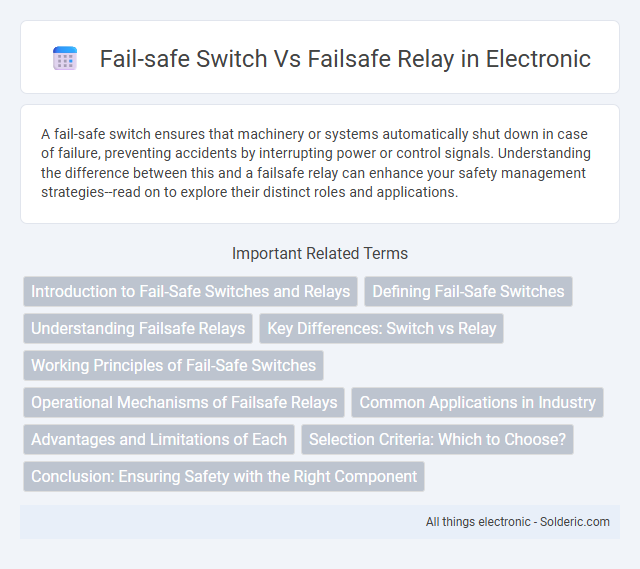A fail-safe switch ensures that machinery or systems automatically shut down in case of failure, preventing accidents by interrupting power or control signals. Understanding the difference between this and a failsafe relay can enhance your safety management strategies--read on to explore their distinct roles and applications.
Comparison Table
| Feature | Fail-safe Switch | Failsafe Relay |
|---|---|---|
| Definition | A switch designed to default to a safe position during failure. | An electrical relay that ensures safe operation upon power or signal loss. |
| Operation | Mechanical or electronic switch; interrupts or maintains circuit safely. | Electromagnetic device; de-energizes to activate safety function automatically. |
| Primary Use | Safety control in machinery, emergency stops. | Industrial automation, circuit protection, safety interlocking. |
| Failure Mode | Switch defaults to off or safe state on fault. | Relay de-energizes causing circuit to open or close safely. |
| Response Time | Instant mechanical action. | Dependent on relay coil energizing/de-energizing speed. |
| Power Requirement | Typically no power needed for default safe state. | Requires power to maintain energized state; safe without power. |
| Applications | Emergency stop buttons, limit switches. | Safety circuits in motors, control panels. |
Introduction to Fail-Safe Switches and Relays
Fail-safe switches and fail-safe relays are critical components in industrial safety systems designed to prevent accidents by ensuring devices default to a safe state during faults. Fail-safe switches typically detect abnormal conditions and immediately deactivate machinery, while fail-safe relays manage electrical circuits to maintain or revert to a safe state under failure scenarios. Both devices enhance system reliability by minimizing risk and ensuring compliance with safety standards such as ISO 13849 and IEC 61508.
Defining Fail-Safe Switches
Fail-safe switches are specialized electrical devices designed to automatically return to a safe position during a power failure or system fault, ensuring operational safety. Unlike failsafe relays, which control circuits to prevent hazardous conditions via relay contacts, fail-safe switches provide direct mechanical or electronic disconnection or activation to mitigate danger. These switches are critical in industrial automation, emergency shutdown systems, and safety interlocks to maintain system integrity and protect personnel.
Understanding Failsafe Relays
Failsafe relays are critical components designed to ensure system safety by maintaining or switching to a safe state when faults occur, differentiating them from simple fail-safe switches that only detect failures without actively controlling outputs. These relays continuously monitor input signals and system conditions, providing reliable fault detection, signaling, and control functions essential in safety-critical applications such as industrial automation and emergency stop circuits. Understanding failsafe relays involves recognizing their role in compliance with safety standards like IEC 61508 and ISO 13849, which mandate precise, redundant, and verifiable switching mechanisms to minimize risk and protect both machinery and operators.
Key Differences: Switch vs Relay
A fail-safe switch directly interrupts or controls the electrical connection through manual or automatic actuation, providing immediate disconnection to prevent hazards. A fail-safe relay, however, uses an electromagnetic coil to control one or more contacts remotely, ensuring circuit control and fault isolation with enhanced reliability in complex systems. Unlike switches, relays enable integration with control logic and automation systems, offering scalable protection in industrial and safety-critical applications.
Working Principles of Fail-Safe Switches
Fail-safe switches operate by defaulting to a safe state when a fault or power loss occurs, ensuring system protection and minimizing hazards. These switches typically rely on mechanical or electrical mechanisms that deactivate or isolate the circuit to prevent damage or injury. Their design prioritizes reliability by automatically engaging fail-safe conditions without requiring external input.
Operational Mechanisms of Failsafe Relays
Failsafe relays operate by continuously monitoring input signals and defaulting to a safe state in the event of power loss or system failure, thereby preventing hazardous conditions. Their operational mechanism involves redundant contact pairs and forced-guided contacts that ensure contacts move together, providing reliable feedback to the control system. This design enables failsafe relays to maintain safety functions even during component failures, distinguishing them from fail-safe switches that primarily rely on mechanical actuation without integrated signal verification.
Common Applications in Industry
Fail-safe switches are commonly utilized in emergency stop systems and safety interlocks, ensuring machine operation halts immediately to protect operators during hazardous conditions. Failsafe relays are predominantly found in safety control circuits, such as those managing emergency shutdowns and safety light curtains, providing reliable signal monitoring and fault detection. Both devices contribute to maintaining workplace safety, with your choice depending on the specific control or monitoring requirements within industrial automation environments.
Advantages and Limitations of Each
Fail-safe switches offer direct mechanical operation that ensures system shutdown during power loss, providing high reliability in emergency situations but may lack flexibility for complex control schemes. Failsafe relays enhance automation and integration with control systems through electrical signaling, allowing for remote monitoring and reset, yet can be vulnerable to electrical faults or relay failure. Each device's selection depends on application-specific trade-offs between mechanical simplicity and electrical control sophistication.
Selection Criteria: Which to Choose?
When selecting between a fail-safe switch and a failsafe relay, consider the application's critical safety requirements and response time. Fail-safe switches provide immediate physical interruption for emergency stops or hazard detection, ideal in machinery requiring direct manual control. Failsafe relays offer automated circuit monitoring with redundancy and fault detection, suitable for complex control systems demanding reliable electrical isolation.
Conclusion: Ensuring Safety with the Right Component
Choosing between a fail-safe switch and a failsafe relay depends on your system's specific safety requirements and application complexity. Fail-safe switches provide direct and reliable mechanical disconnection, ideal for simple emergency stops, while failsafe relays offer advanced monitoring and control capabilities for complex safety circuits. Ensuring safety with the right component involves evaluating fault tolerance, response time, and integration with your overall safety system to prevent accidents and protect personnel effectively.
fail-safe switch vs failsafe relay Infographic

 solderic.com
solderic.com